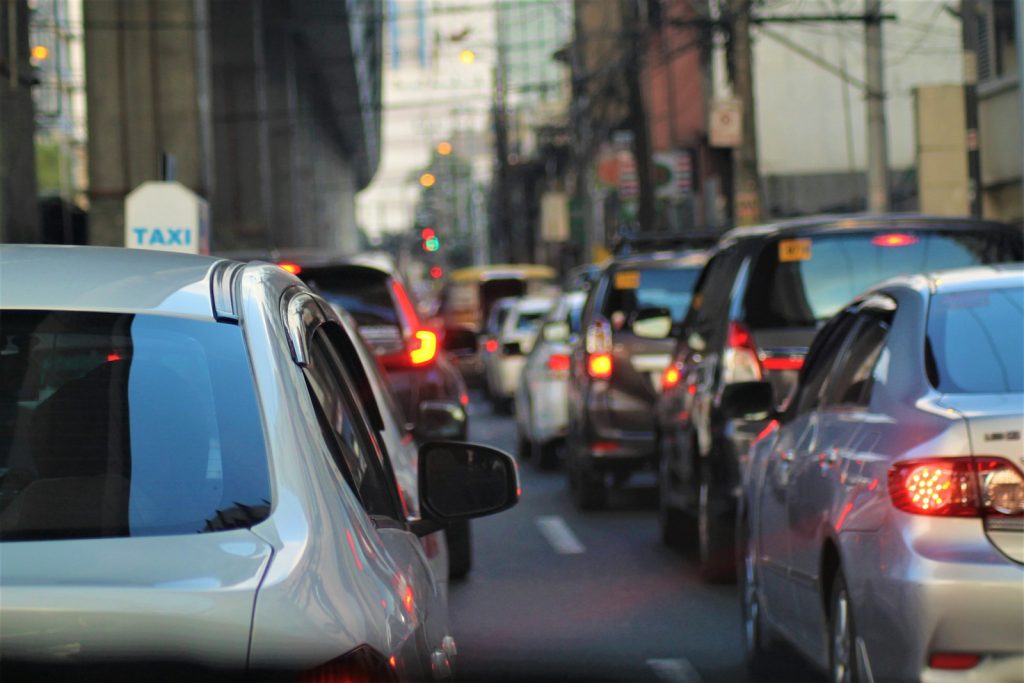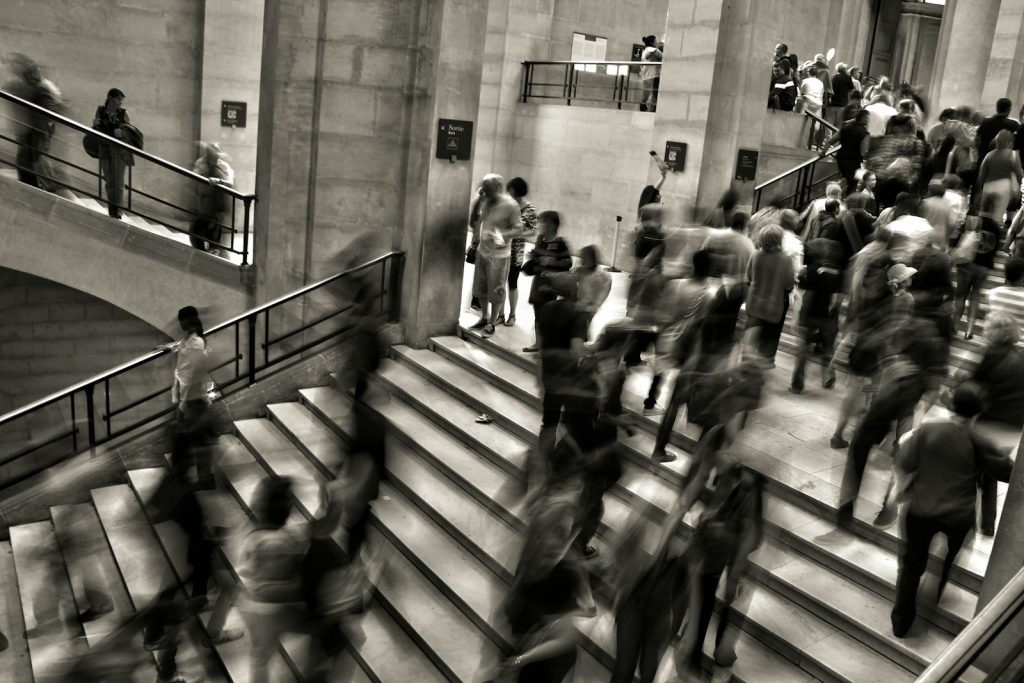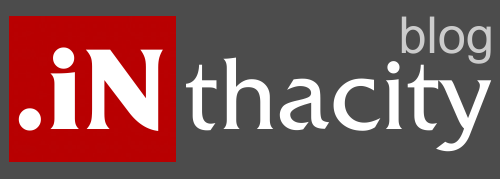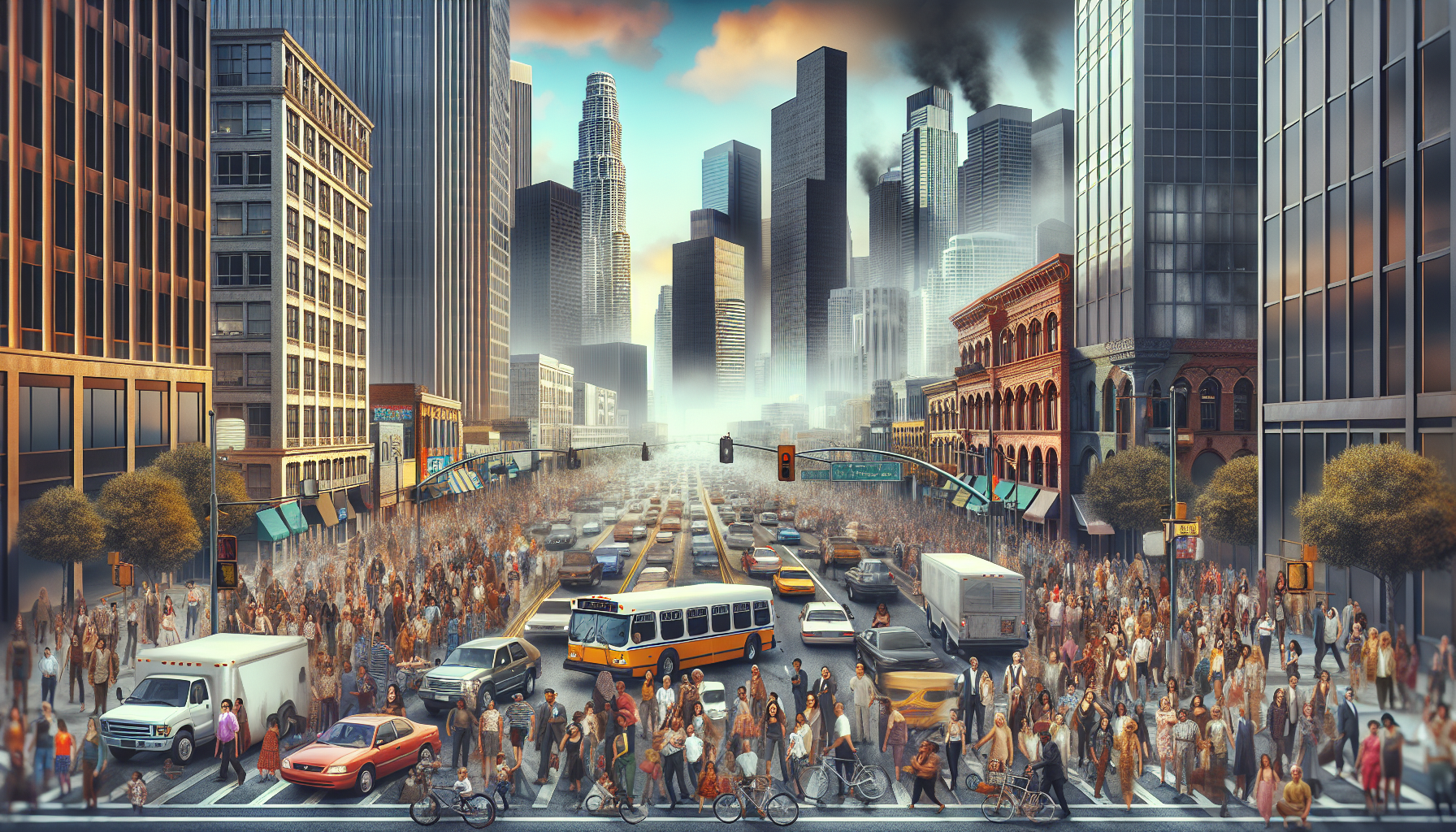City Living Disadvantages (in the US and Canada)
Living in the city has its perks, but let's be real—it ain't all sunshine and rainbows. Here, we break down the main headaches of urban life, focusing on environmental messes, health issues, traffic nightmares, and wallet-draining housing costs.
Environmental Impact
Cities are like resource-hungry monsters. They gobble up energy, spit out pollution, and leave a trail of waste. With so many people packed into one place, air and water quality take a hit. Cities are the culprits behind about 75% of global greenhouse gas emissions, thanks to cars, buildings, and waste (Geneva Environment Network).
| Environmental Issue | Impact |
|---|---|
| Air Pollution | Sky-high levels from cars and factories |
| Water Quality | Polluted by waste and industrial runoff |
| Energy Consumption | Massive demand, leading to more emissions |
| Waste Disposal | Struggles to manage mountains of trash |
Health Disparities
City life can be a health hazard. Breathing in polluted air can mess up your lungs, and the hustle and bustle can stress you out. Plus, not everyone in the city has the same access to healthcare, which means some folks get left behind.
- Physical Health: More asthma and other lung problems from dirty air.
- Mental Health: Stress and anxiety from the fast-paced city grind.
- Healthcare Access: Big gaps in healthcare quality and availability.
Want to know more about how city and country living stack up health-wise? Check out our Urban vs. Rural Health Disparities section.
Traffic and Parking Challenges
Getting around in the city can be a real pain. Traffic jams are the norm, making your commute feel like a never-ending saga. And good luck finding a parking spot that doesn't cost an arm and a leg.
| City | Average Commute Time (minutes) | Parking Cost (monthly) |
|---|---|---|
| New York City | 38 | $570 |
| Los Angeles | 31 | $250 |
| Chicago | 34 | $300 |
If you value convenience and hate sitting in traffic, city life might not be for you. For tips on escaping the urban jungle, check out our article on leaving big cities.
Housing Affordability Concerns
One of the biggest bummers about city living is the cost of housing. Rent and home prices are sky-high, making it tough to find a place that doesn't break the bank (Pew Research Center).
| City | Average Rent (1-bedroom) | Median Home Price |
|---|---|---|
| San Francisco | $3,500 | $1,350,000 |
| New York City | $3,000 | $900,000 |
| Boston | $2,700 | $750,000 |
Housing costs are a huge chunk of your budget in the city. For tips on managing these expenses, visit our Strategies for Cost Management section.
City living has its upsides, but don't ignore the downsides when deciding where to plant your roots. Check out the benefits of living in a big city and weigh the pros and cons to make the best choice for you.
 traffic jam" width="640" height="427" />
traffic jam" width="640" height="427" />
Urban vs. Rural Health Disparities
Let's talk about the health differences between city folks and country folks. It's not just about the scenery; where you live can seriously impact your health. Knowing these differences can help you make smarter choices about where to call home.
Physical Health Disparities
When it comes to physical health, the gap between urban and rural populations is pretty wide. People living in rural areas are more likely to smoke, drink too much, and struggle with weight issues (Georgetown University). They also deal with more chronic conditions and physical limitations.
| Health Metric | Rural Population (%) | Urban Population (%) |
|---|---|---|
| Fair to Poor Physical Health | 17 | 12 |
| Chronic Conditions | 30 | 20 |
| Activity Limitations | 33 | 24 |
These numbers show that rural residents face more physical health challenges than city dwellers.
Mental Health Disparities
Mental health is another area where city and country living differ. More people in rural areas report poor mental health compared to those in urban settings. The shortage of mental health professionals in rural areas makes things worse, leading to untreated mental health issues.
| Mental Health Metric | Rural Population (%) | Urban Population (%) |
|---|---|---|
| Fair to Poor Mental Health | 20 | 13 |
| Access to Mental Health Services | 40 | 60 |
Rural folks often struggle to find mental health services, which contributes to higher rates of poor mental health.
Access to Healthcare Disparities
Access to healthcare is a big deal. Rural residents are less likely to get tested for chronic conditions, including cancer. Fewer rural adults get screened for prostate, breast, colon, and skin cancer, showing a clear gap in preventive care.
| Healthcare Access Metric | Rural Population (%) | Urban Population (%) |
|---|---|---|
| Cancer Screenings | 50 | 70 |
| Uninsured for Longer Periods | 25 | 15 |
| Regular Doctor Visits | 60 | 80 |
These disparities highlight the need for better healthcare services in rural areas.
Understanding these health disparities can help you decide where to live. For more on the pros and cons of city living, check out our articles on small town vs city living and city living worth.

Cost of Living in Cities
Rising Inflation and Cost of Living
Even though inflation has slowed a bit, the cost of living keeps climbing. Groceries, for example, have gotten pricier, forcing folks to shell out more just to keep up with their usual lifestyle. According to the U.S. Bureau of Labor Statistics (BLS), consumer prices jumped 3.2 percent from February 2023 to February 2024, with food costs alone going up by 2.2 percent. This hits city dwellers hard, making urban life more expensive.
Impact of Rent Costs
Rent has shot up a lot over the past year. Zillow's Observed Rent Index for February shows a 3.5 percent year-over-year increase and a whopping 29.9 percent rise since the pandemic started. This spike in rent makes it tough for people to find affordable housing in cities, adding to the city living headaches.
| Year | Rent Increase (%) |
|---|---|
| February 2023 - February 2024 | 3.5 |
| Since Pandemic Start | 29.9 |
Housing Expenses as a Major Factor
Housing is usually the biggest chunk of living costs, eating up a large part of most Americans' budgets. Shelter inflation rose by 5.7 percent in February 2024, outpacing the overall inflation level of 3.2 percent (Bankrate). This shows how crucial it is to think about housing costs when figuring out city living expenses.
The impact of housing costs is clear when you compare mortgage payments and rent across different cities. For instance, the average monthly mortgage payment in Calgary is $3,077, which is over $1,000 less than the average monthly mortgage payment of $4,137 in a mix of 10 Canadian cities (Minto). Plus, renting a one-bedroom apartment in Calgary's city center costs $1,730 compared to $1,887 in the composite of 10 Canadian cities.
| City | Average Monthly Mortgage Payment ($) | One-Bedroom Rent Cost ($) |
|---|---|---|
| Calgary | 3,077 | 1,730 |
| Composite of 10 Canadian Cities | 4,137 | 1,887 |
For more insights on the cost of living comparisons in various cities, check out our articles on most affordable city and most expensive city.
Understanding these factors can help city folks and those thinking about moving to a city make smart choices about their housing options. For tips on managing living expenses in cities, visit our guide on living expenses.
Cost of Living Comparisons
Calgary vs. Other Canadian Cities
Calgary is a wallet-friendly gem compared to many other Canadian cities. Living in Calgary is 11.1% cheaper than in Toronto. A budget of $4,229.60 in Calgary gives you the same lifestyle as $4,700 in Toronto (Minto). This makes Calgary a great pick for those wanting to stretch their dollars further.
| City | Monthly Budget for Similar Living Standard |
|---|---|
| Calgary | $4,229.60 |
| Toronto | $4,700 |
Cost of Housing in Calgary
Housing in Calgary is a steal compared to other big Canadian cities. The average monthly mortgage payment in Calgary is $3,077, which is over $1,000 less than the $4,137 average in a mix of 10 Canadian cities (Minto). Renting is also easier on the pocket, with a one-bedroom apartment in the city center costing $1,730 in Calgary versus $1,887 in the composite.
| Housing Type | Calgary | Composite of 10 Canadian Cities |
|---|---|---|
| Average Monthly Mortgage Payment | $3,077 | $4,137 |
| Rent for One-Bedroom Apartment (City Center) | $1,730 | $1,887 |
Average Salaries in Calgary and Comparison
The average yearly salary in Calgary is $61,400, which is 13.7% higher than the average yearly salary in the rest of Canada, which stands at $54,000 (Minto). This higher income helps to balance out living expenses, making Calgary an attractive option for city dwellers.
| Location | Average Yearly Salary |
|---|---|
| Calgary | $61,400 |
| Rest of Canada | $54,000 |
Thinking about moving? Check out other factors like the impact of rent costs and housing affordability concerns for a full picture. Also, comparing the cost of living in different cities can help you decide if city living is worth it.
What Affects the Cost of Living?
Figuring out what makes living in a city expensive can help you decide where to live or if you should move. Here’s what you need to know:
Prices and Inflation
The Consumer Price Index (CPI) shows how prices change over time for things we buy every day. Even if inflation slows down, living costs keep climbing. Groceries, for example, have gotten pricier, meaning you need more money to live the same way you did a few years ago. The U.S. Bureau of Labor Statistics (BLS) says prices went up 3.2% from February 2023 to February 2024, with food costs rising 2.2% (Bankrate).
Mortgage Payments
Mortgage payments are a big part of city living costs. Rent has jumped a lot in the past year. Zillow's Observed Rent Index for February showed a 3.5% increase from last year and a whopping 29.9% rise since the pandemic started (Bankrate). If you’re buying a home, your monthly mortgage can vary a lot depending on where you live and the housing market.
| Metric | Value |
|---|---|
| Year-over-Year Rent Increase | 3.5% |
| Rent Increase Since Pandemic | 29.9% |
Renting in Calgary
Calgary is cheaper for renters compared to other Canadian cities. The average monthly mortgage in Calgary is $3,077, which is over $1,000 less than the $4,137 average in 10 other Canadian cities. Renting a one-bedroom apartment downtown costs $1,730 in Calgary, compared to $1,887 in those other cities (Minto).
| Rental Cost Comparison | Calgary | Composite of 10 Canadian Cities |
|---|---|---|
| Average Monthly Mortgage Payment | $3,077 | $4,137 |
| One-Bedroom Apartment (City Center) | $1,730 | $1,887 |
Want to know more about city living? Check out our articles on the most affordable city, most expensive city, and is city living worth it. Also, comparing small town vs city living might help you decide what’s best for your lifestyle and budget.
Urban Environmental Challenges
Living in a city has its perks, but it also comes with some serious environmental headaches. If you're thinking about moving to a city or already live in one, it's good to know what you're up against, especially when considering the cost of living in different American cities.
Air and Water Pollution
Air pollution is a big deal in cities. With all the cars, buses, and factories, the air can get pretty nasty. According to the Geneva Environment Network, 9 out of 10 people in urban areas are breathing air that's worse than what the WHO recommends. This can lead to all sorts of health problems, like asthma and heart disease.
Water isn't off the hook either. Cities struggle to provide clean water, especially in poorer neighborhoods. Dirty water can cause diseases that make people really sick.
| Pollution Type | Impact | Source |
|---|---|---|
| Air Pollution | Breathing issues, heart problems | Cars, factories |
| Water Pollution | Diseases from dirty water | Polluted water sources |
Want to know more about how these issues affect health? Check out our section on Urban vs. Rural Health Disparities.
Greenhouse Gas Emissions
Cities pump out about 75% of the world's greenhouse gases. Cars, buildings, power plants, and trash all play a part. These gases mess with the climate, causing crazy weather and rising sea levels. Over 130 port cities with more than a million people are at risk of flooding, which could affect a billion people living in slums.
| Sector | Contribution to GHG Emissions |
|---|---|
| Transport | High |
| Buildings | High |
| Energy | High |
| Waste Management | Moderate |
Thinking about whether city living is worth the environmental cost? Keep these points in mind.
Biodiversity Loss and Urbanization
Urbanization is a major threat to wildlife. Cities change the land, mess with the climate, pollute the soil and water, and bring in invasive species that push out native ones. Protecting nature in cities is crucial to stop this biodiversity crisis.
| Threat | Impact on Biodiversity |
|---|---|
| Land-Use Change | Destroys habitats |
| Climate Change | Changes ecosystems |
| Nitrogen Deposition | Pollutes soil and water |
| Invasive Species | Pushes out native species |
Knowing these challenges can help you decide if leaving big cities is the right move or if you should adapt to urban life. For more on how these factors affect the cost of living comparisons, check out our detailed sections.

Strategies for Cost Management
Living in a city can be a blast, but it also comes with its own set of financial headaches. Here are some practical tips to help you keep your wallet happy while enjoying the urban jungle.
Budgeting Tips
First things first, you gotta have a budget. Track your monthly expenses and see where you can trim the fat. Groceries, for example, have been getting pricier lately (Bankrate). Use budgeting apps or good old spreadsheets to keep tabs on your spending.
| Expense Category | Percentage of Budget |
|---|---|
| Housing | 30% |
| Food | 15% |
| Transportation | 10% |
| Utilities | 5% |
| Savings | 10% |
| Miscellaneous | 30% |
Want more budgeting hacks? Check out our article on living expenses.
Finding Affordable Housing
Rent is usually the biggest chunk of your expenses. With rent prices climbing, it's smart to hunt for affordable options. According to Zillow, rent has jumped by 3.5% year-over-year and a whopping 29.9% since the pandemic started (Bankrate).
Here are some tips to save on rent:
- Look in less trendy neighborhoods.
- Roommates can be lifesavers for splitting costs.
- Check out rent-controlled or subsidized housing.
- Don’t be shy—try negotiating rent with your landlord.
For more tips on finding affordable housing, visit our guide on the most affordable city to live in.
Adapting to Cost of Living Changes
Inflation can really mess with your budget. The Consumer Price Index (CPI) tracks inflation, which affects the cost of living. Higher inflation means you’ll need to adjust your spending (Bankrate).
Here’s how to roll with the punches:
- Regularly tweak your budget.
- Boost your income with side gigs or part-time jobs.
- Take advantage of cost of living adjustments (COLA) like the 3.2% increase announced by the Social Security Administration (SSA) for 2024.
- Hunt for discounts and use coupons to save on groceries and other essentials.
For more tips on adapting to cost of living changes, read our article on city living worth.
By following these strategies, you can tackle the financial challenges of city life and still enjoy all the perks of living in a bustling urban environment.






